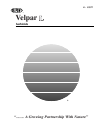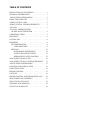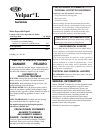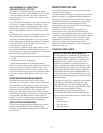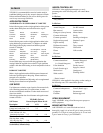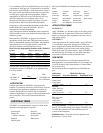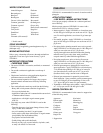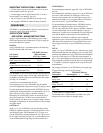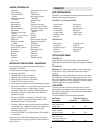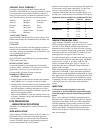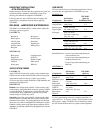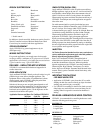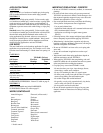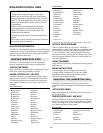
REPLANTING (FOLLOWING ALFALFA)
• Do not replant treated areas to any crop except corn, root
crops or sugarcane within two years after treatment, as crop
injury may result.
• Corn may be planted 12 months after the last treatment,
provided the use rate did not exceed 3 pt per acre, except in
areas of low rainfall (20" or less).
• Root crops such as potatoes, sugarbeets, radish and carrots
may be planted 12 months after last treatment, provided the
use rate not exceed 2 pt per acre. Sites with use rates
higher than 2 pt per acre should not be replanted to any
crop within 2 years of application, or unacceptable crop
injury may result.
• Sugarcane may be planted any time following treatment.
• In California, do not replant seed alfalfa areas to any crop
within two years after treatment, as crop injury may result.
IMPORTANT PRECAUTIONS - ALFALFA ONLY
Best results are obtained when 1/2–1" of rainfall or sprinkler
irrigation occurs within two weeks after application, when
soil is moist at time of application, and when weeds have not
germinated or are less than 2" in height or diameter. Heavy
rainfall or excessive irrigation after application may result in
crop injury or poor performance of the herbicide.
• Do not apply to snow-covered or frozen ground.
• On soils high in organic matter (greater than 5%), the
effectiveness of VELPAR L can be significantly reduced
and weed control may be unsatisfactory.
• Since the effect of VELPAR L on alfalfa varies with soil
conditions, uniformity of application, and environmental
conditions, growers should limit their first use to small
areas.
• If abnormally dry conditions exist following application,
restrict the first irrigation to no more than 1/2 acre inch of
water.
• Temporary yellowing of alfalfa may occur following
VELPAR L applications.
• Treat only stands of alfalfa established for one year or for
one growing season(except in California), provided the
following conditions are met:
–The alfalfa root system must be well established.
–The crop must be healthy, vigorous and not under stress
from adverse weather conditions, insect or disease
damage.
–The alfalfa crop must be free of excessive winter injury
from freezing and thawing.
• In California, fall planted alfalfa may be treated in the
following winter months with VELPAR L at 1 to 2 pts per
acre to suppress or control Black Mustard, Common
groundsel, London rocket, Shepard’s-purse, Common
chickweed, Fiddleneck or Filaree, provided:
- alfalfa root growth exceeds 6 inches in length
- vegetative top growth of alfalfa has lateral development of
secondary growth
- alfalfa is healthy and vigorous, not growing under stress
from insect, disease, winter injury or other types of stress.
Injury may result to alfalfa plants that fail to meet these
growth criterion listed above.
• Do not use VELPAR L on seedling alfalfa, alfalfa-grass
mixtures, or other mixed stands as injury may result to the
seedling alfalfa or companion crop.
• At elevations above 4,000 ft, do not use VELPAR L on
alfalfa that has been established with a cover or nurse crop
until the alfalfa has gone through two summer growing
seasons.
• Do not use VELPAR L in low desert valleys in California
or Arizona.
• Do not exceed 3 pt per acre on alfalfa less than one year
old.
• Do not add a surfactant to VELPAR L when treating
nondormant alfalfa varieties.
• Do not use VELPAR L on gravelly or rocky soils, exposed
subsoils, hardpan, sand, poorly drained soil, or alkali soils.
• Crop injury, including mortality, may result in fields with
restricted root growth due to nonuniform soil profiles
such as gravel bases and clay lenses.
• Do not graze or feed forage or hay to livestock within 30
days following application.
SEED ALFALFA (CALIFORNIA ONLY) -
ADDITIONAL PRECAUTIONS
• Do not use VELPAR L on fields with sandy loam or
loamy sand soils having less than 1% organic matter.
• Do not exceed 2 pt per acre on fields with sandy loam or
loamy sand soils having 1–2% organic matter.
• Do not exceed 2 pt per acre on seed alfalfa that has been
established for only one growing season.
Dry bulk fertilizer may be impregnated or coated with
VELPAR L for application to established alfalfa. All
recommendations, cautions and special precautions on this
label must be followed along with state regulations relating to
dry bulk fertilizer blending, impregnating and labeling. Keep
VELPAR L from heat, sparks, and open flame. (Refer to the
material safety data sheet [MSDS] for VELPAR L.)
If fertilizer materials are excessively dusty, use a suitable
additive to reduce dust prior to impregnation, as dusty
fertilizer will result in poor distribution during application.
The dry fertilizer must be properly impregnated and
uniformly applied to the alfalfa to avoid crop injury and/or
poor weed control.
To impregnate the fertilizer, use a system consisting of a
conveyor or closed drum used to blend dry bulk fertilizer. Any
commonly used fertilizer can be impregnated with VELPAR
L, except potassium nitrate or sodium nitrate. Do not use
VELPAR L on limestone.
ALFALFA - IMPREGNATION ON
DRY BULK FERTILIZER
(EXCEPT
CALIFORNIA AND ARIZONA)
4



